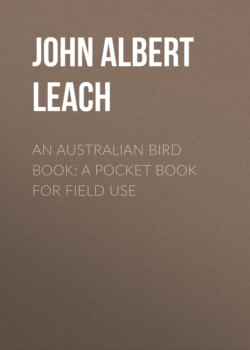Читать книгу An Australian Bird Book: A Pocket Book for Field Use - John Albert Leach - Страница 16
На сайте Литреса книга снята с продажи.
ORDER III.—TURNICIFORMES, HEMIPODES.
ОглавлениеTable of Contents
F. 14. TURNICIDAE (8), Button (Bustard) Quail, 27 sp.—14(14)A., 9(6)O., 3(0)P., 4(4)E.
7
26
7 Red-Backed Quail (Black-backed, Orange-breasted), Turnix maculosa, Cel., N.G., N.A., E.A., S.A.
Nom. r. marshy 7
Back brown; crown blackish; sides, breast large black spots; abdomen lighter; no hind toe; f., larger. Weed-seeds, insects.
8* Painted Quail (Speckled, Butterfly), Varied Turnix, New Holland Partridge (e), T. varia, A., T.
Nom. r. sandy 8
Upper rufous-brown with buff, black lines; breast, face spotted; no hind toe; f., larger. Weed-seeds, insects.
9 Red-chested Quail (Chestnut-breasted, Yellow), T. pyrrhothorax, A. exc. W.A.
Nom. v.r. marshy 6
Upper dark-brown with buff, black lines; breast sandy-red; abdomen whitish; no hind toe; f., much larger, brighter. Weed-seeds, insects.
10 Little Quail (Dottrel, Swift-flying, Button), T. velox, A.
Nom. c. open plains 5.5
Upper rufous with chestnut, black lines; breast rufous; abdomen white; no hind toe; f., much larger. Weed-seeds, insects.
1
1
11* Plain Wanderer, Turkey Quail, Pedionomus torquatus, A. exc. W.A.
Mig. r. grass, m., 4.8; f., 6.3
Brown; broad black, white spotted collar; light band on wing; breast chestnut; hind toe; m., smaller, paler, faint collar. Weed-seeds, insects.
F. 15. Pteroclididae, Sand-Grouse, Rock-Pigeons (e), 17 sp.—7(2)O., 8(1)P., 12(7)E.
In Order IV. come those well-known birds—the "Cooers," Pigeons and Doves. The Australian region is the great stronghold of these often beautiful birds. It is only in this region that members of each of the five families of living Pigeons are found. Two of the five families are peculiar to the region, and nearly half the kinds of Pigeons known are found here. The finest and largest of all Pigeons are the large Crowned Pigeons of New Guinea. Unfortunately, the heads of these Pigeons are much in demand for millinery. Would that fashionable women knew the cruelty and devastation wrought by such fashions!
Amongst the most beautiful of Pigeons are, as Dr. Newton remarked, the common Bronzewing Pigeons of Australia and Tasmania. The lovely Fruit-Pigeons of East Australian scrubs are, perhaps, the most beautiful of all, so it will readily be seen how fortunate we are with regard to these birds.
The fine large Wonga-Wonga Pigeon is becoming rare. Its flesh is white, so Gould named it Leucosarcia (white flesh). It has been proposed to introduce this bird into Europe to breed for table purposes.
